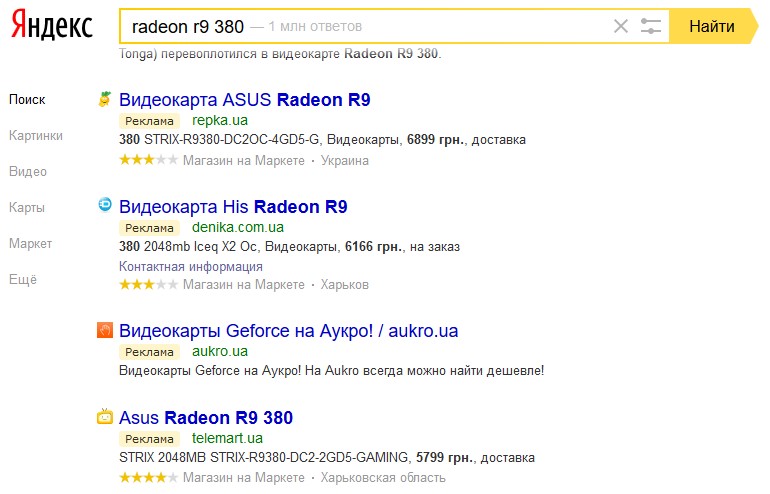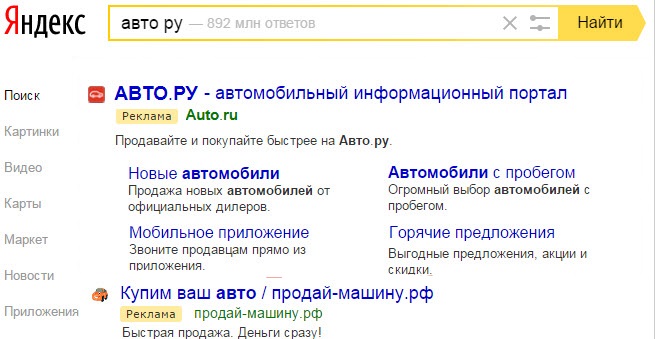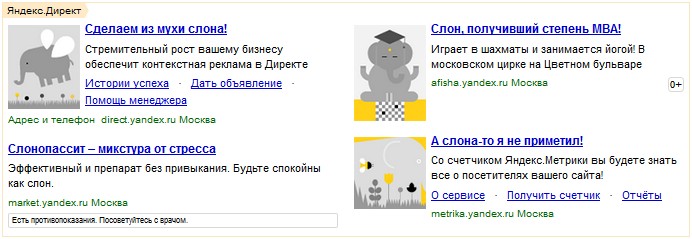Best Practices for Creating Effective PPC Ads
 In this article, I would like to talk about the key click-through factors in the context (we highlighted 3), about 10 tricks that you can use when creating an ad for the context, as well as how to do competitor analysis and about the features of Google AdWords and YAN.
In this article, I would like to talk about the key click-through factors in the context (we highlighted 3), about 10 tricks that you can use when creating an ad for the context, as well as how to do competitor analysis and about the features of Google AdWords and YAN.
Magic words exploding CTR
 Articles roam the Internet saying that in 5 minutes you can make a stunning headline, that there are only a couple of dozen words that can sell snow to an Eskimo, and so on. The articles even have a list of these magic words (“discount”, “inexpensive”, “reduced”, “hurry up”, etc.) that instantly influence the decision of users. They supposedly significantly increase the click-through rate of the ad. We will not deny that there is some truth in these words, but, nevertheless, it is worth considering the following:
Articles roam the Internet saying that in 5 minutes you can make a stunning headline, that there are only a couple of dozen words that can sell snow to an Eskimo, and so on. The articles even have a list of these magic words (“discount”, “inexpensive”, “reduced”, “hurry up”, etc.) that instantly influence the decision of users. They supposedly significantly increase the click-through rate of the ad. We will not deny that there is some truth in these words, but, nevertheless, it is worth considering the following:
- The bulk of the flocked users to such ads are lovers of freebies. The bulk of such traffic is “dirty”. Do you need it? Think for yourself. Unless the low price is the main condition of the product.
- Chips like "inexpensive", "discount" do not work in all directions. For example, if a company sells oil refining or agricultural equipment, it is unlikely that a person will search for it using the term “inexpensive” or “discount”. Or if the company offers a unique product that has nothing to compare with and where the price is not considered in the first place.
Such lures work well in B2C.
- A high CTR does not mean big sales. The indicators will depend on the next stages of the sales funnel - the offer placed on the landing page and directly from the managers working with orders.
It will be correct to consider the return when calculating the ROI of an advertising campaign in principle.
To increase click-through rate, many advertisers scribble the words “promotions” and “discounts” everywhere. Even where there are no bonuses. Firstly, by doing this, you lose the trust of the user, and secondly, this will only be a transition for which you will pay. In this case, there will be no conversion.
Competitor analysis
 Analyze competitor offers. Make a table where each sentence will be analyzed in detail: Title, text, quick links, geotags, the presence of keywords in the title, etc. With the help of such a plate, you can understand the pros and cons of competitors' ads, what should be emphasized.
Analyze competitor offers. Make a table where each sentence will be analyzed in detail: Title, text, quick links, geotags, the presence of keywords in the title, etc. With the help of such a plate, you can understand the pros and cons of competitors' ads, what should be emphasized.
For example, let's look at a specific example of an ad with such a request as "Buy an iPhone". So, we look at the positions, we draw conclusions:
- The iPhone brand name is here for branding purposes. The name, so to speak, speaks for itself. The plus is that there is a quick link "Buy" and the title is expanded. The text in the title is also the slogan for the release of the iPhone 6S gadget. He focuses not on profit, but on the image.
- The site address is also pulled up to the title with the key phrase. The advantage for this ad is that the site has twice the rating in Yandex Market, compared to the previous participant. And this is quite a strong incentive for a potential client.
- Short title with keyword. What's good for this ad: Headline imperative, calling to action; phone number appears. The second and third ads are quite standard and do not have an offer. They include the usual set of empty phrases such as “great choice”, “quality”, “fast delivery”, etc., which is typical for market leaders.
Still, it is worth noting that such a request is rather vague and it is not clear by what criteria the user should choose a device. Let's try to change it by adding some triggers.
Making your ad attractive
 We take the same request (judging by the fact that there is no model name, parameters, etc., the client chooses any one he likes).
We take the same request (judging by the fact that there is no model name, parameters, etc., the client chooses any one he likes).
The offer of this announcement will be price and fast delivery. So, what we got: “Buy an iPhone from 4300 UAH! Delivery today! The header is expanded. Recall that not so long ago, Direct allowed headlines up to 56 characters (it was up to 33).
If the title is small, Direct will pull up the site address. Therefore, it would be better to include useful information that attracts the attention of users into the allowed limit.
You can initially opt out of the expanded header by making certain settings in the campaign settings.
In the text, you can also focus on authenticity, reliability, etc., indicate the warranty period and add a bun in the form of a gift (case or something like that).
In the corresponding tab in the ad editor, you can add quick links. These can be, for example, links to specific models. Here, in quick links, we enter the mode of operation and contacts.
Key Points Affecting CTR
 Based on our practice, we can highlight 3 key points that can affect the clickability of an ad:
Based on our practice, we can highlight 3 key points that can affect the clickability of an ad:
- Accurate target audience selection. This is to weed out inappropriate traffic. There are times when even non-targeted traffic has value (for the sake of branding), but this is rare.
- The request is at the exact match in the header. This is the first thing that catches the eye of users. Direct highlights key phrases in the ad text, title, and sitelinks.
- Triggers and benefits. Analyze client benefits regarding a specific request. Possibility of purchase on credit, price, goods in stock. Give specific information without "water".
For example, if you take an assortment of a rebar plant and expand the semantics of the site to include exact queries from the assortment, you can get traffic from users who know what they are looking for.
Another example: the announcement of a company engaged in the purchase and exchange of cars. We take a request in the direct entry "Auto Exchange". We analyze that for the audience of such a service it is important to quickly evaluate the car and quickly get money for it. We supplement the heading with the appropriate triggers and get “Auto exchange. Reliable, profitable!
It's simple: you need to give people what they expect from such an announcement. This is the benefit of target audience segmentation and its analytics. And to highlight the ad visually, we suggest using 10 working methods.
10 tips for working with ads

They make your ad stand out from the rest:
- Use an expanded title. Show the benefit in the title.
- Use question and exclamation marks at the end of your ad title and text. Remember that everything is good, but in moderation. You do not need to put these signs at the end of each sentence.
- Extended operating mode format. By making certain settings, you can show the user a detailed work schedule broken down by day.
- A catchy favicon. By default, it is displayed in Yandex.Direct, of course, provided that it is on the site. The original favicon looks like this:
- Trigger arrows. Reported as benefits. And we make out the advantages, starting from the needs of the audience. Therefore, you should not sculpt links “Contacts”, “About us” and the like in the ad. Post what your users really care about.
- Geolocation (pointers of the city, district, metro).
- Phone numbers in the extension (located under quick links).
- Delivery times and cost of goods. If cost is the main selection criterion, show it in the ad. Perhaps this will set you apart from your competitors. Plus, you immediately cut off those for whom it is expensive.
- What is the user's task: to leave a request, call, receive some kind of bonus? Choose emotional appeals carefully. Such as “Press” is better to save for YAN, that is, where the corresponding model of user behavior is.
- Rating in Yandex Market. Display in the ad when it is 4-5. Fewer stars can backfire.
Announcements in YAN

Here, a different model of audience behavior, respectively, and the criteria for creating an ad are different. Users do not come here specifically for your offer.
Here's what to consider:
- Alluring pictures. In YAN, the visual component of the ad plays a big role. Therefore, we pay special attention to teaser pictures.
- Emotional ad text. Add emotion to your headlines. Make it so that it clings to the living.
- Emotional call. “Come in!”, “Press!”, “Look!”, add maximum emotions to the call. Just what does not always work in the search should be in YAN!
But what about Google?
Now the principles of working in Yandex.Direct do not differ much from those of AdWords. There is a small clarification on Google: the presence of an additional line under the quick links, in which you can enter important information that was not included in the ad text.
